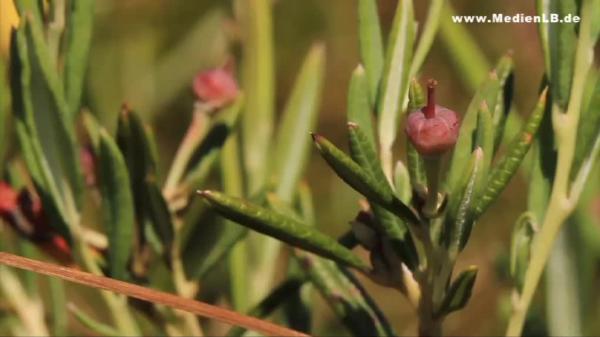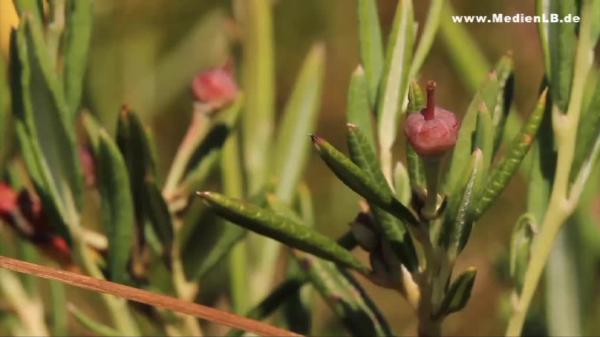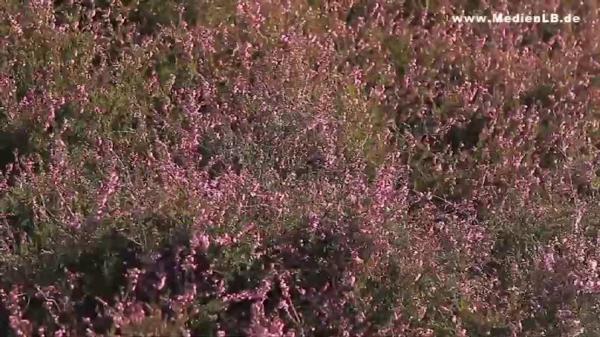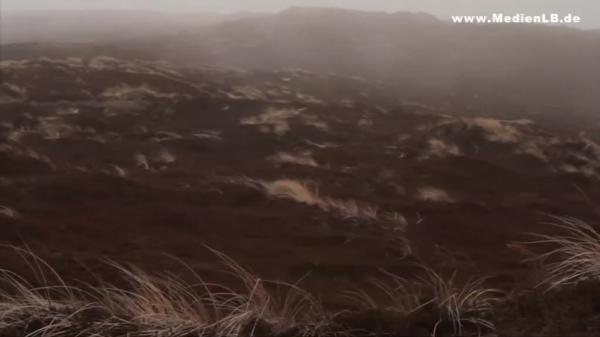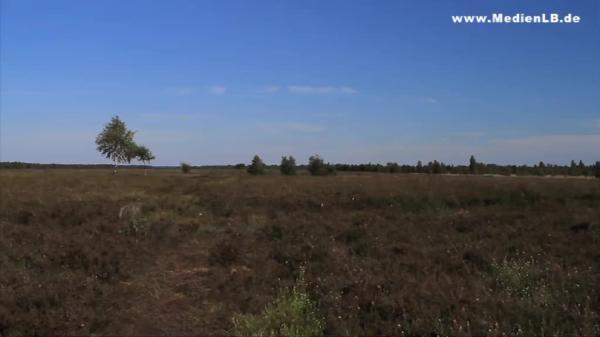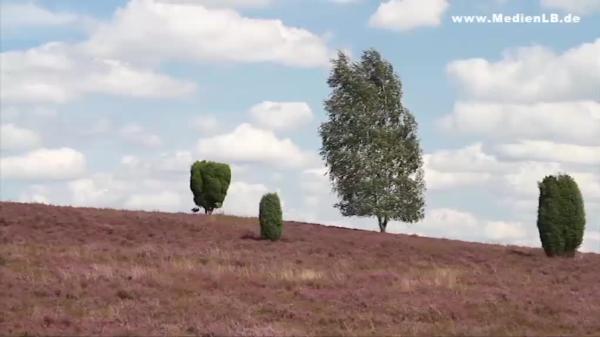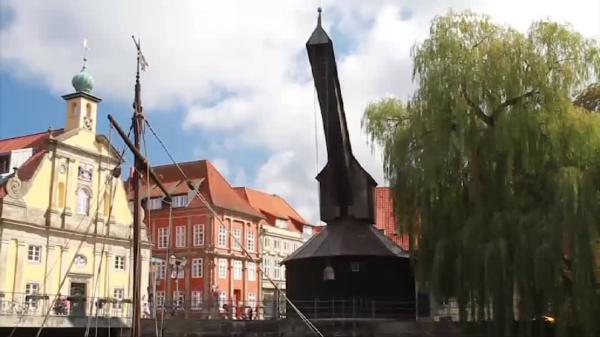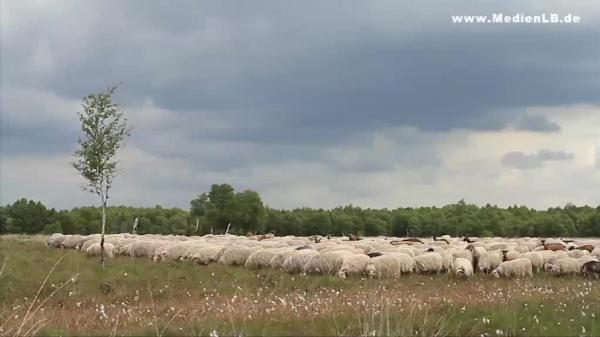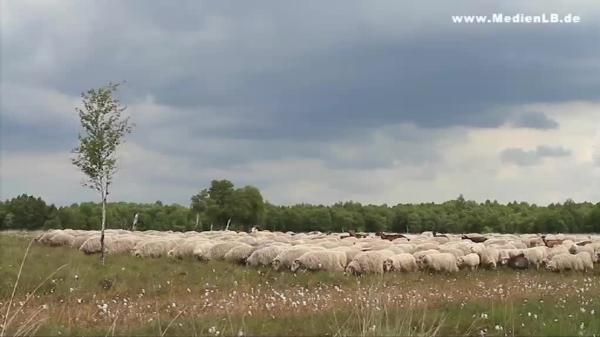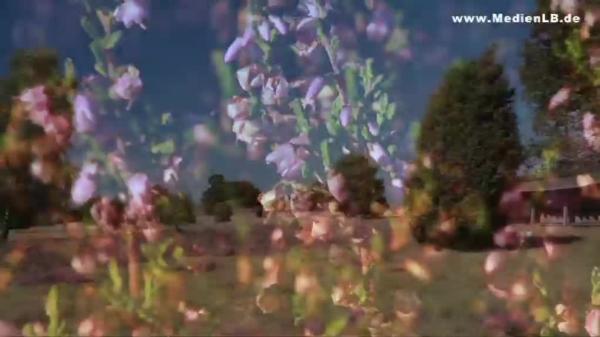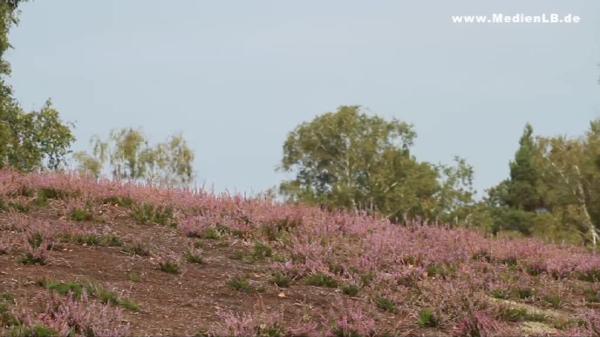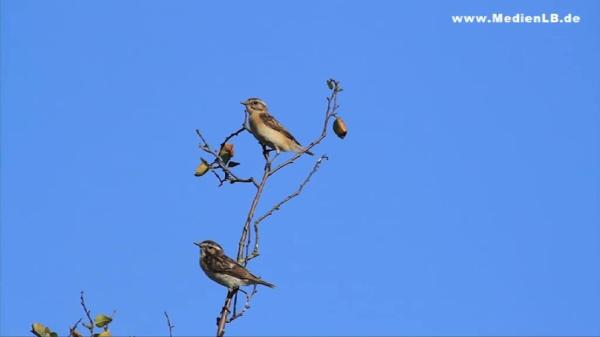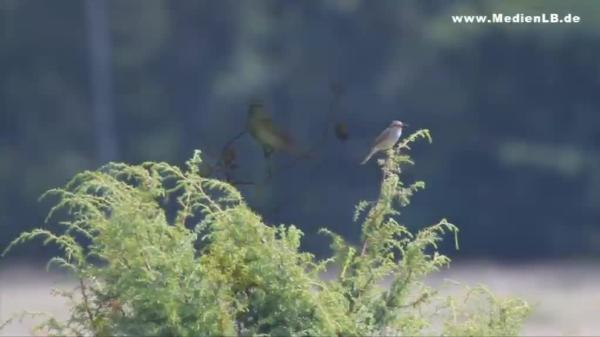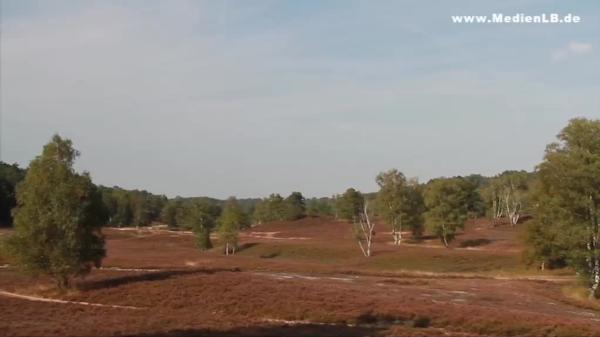Heide
Kulturlandschaft im Wandel

Heath – a Cultural Landscape in Transformation

One of the last big heathland areas in Germany is located west of the Lower Saxon town of Lüneburg – the Lüneburg Heath Nature Reserve. 200 years ago, large parts of Northern Germany looked like that. In the Middle Ages, plundering nature contributed to the spread of heathlands. Today they are seriously threatened together with their inhabitants. But what is the special attraction of this landscape? 1. Frequently Occurring Heather Plants 1.1 Cross-leaved Heath and Bog Rosemary Heather plants are mostly evergreen dwarf shrubs. With its height of up to 30 centimetres the bog rosemary is the most inconspicuous species. It flowers already from May onwards, thus being the first of the three frequent pink-blossomed heather species. Its leaves are similar to those of the rosemary – therefore its name. However, it is not suitable for seasoning: the bog rosemary is poisonous. The cross-leaved heath, up to one and a half metres high, blossoms from June to August. Its inflorescence consists of 5 to 15 rather large ovate flowers which are preserved as seed capsules. Like the bog rosemary, the cross-leaved heath does not occur frequently around here as its natural habitat has shrunk dramatically because of afforestation and overfertilisation. The cross-leaved heath is still found in Northwest Germany, above all in sufficiently dry boggy areas. 1.2 Common Heather The characteristic heather of our latitudes is the “common heather“, a pink-blossomed shrub as well and not more than knee-high. Tiny, only millimetre-long leathery leaflets sprout from its dry, bristly twigs. As it was not good for much more than the making of besoms the generic name of the rumpled shrub was Calluna, from the Greek for “sweeping”. Only once a year, from July to September, a carpet of millions of bright blossoms covers the monotonously brown-yellow landscape of the Lüneburg Heath. They droop from the inflorescence like small bells. As its nectar is easily accessible and rich in sugar, the common heather now attracts a great number of insect species. 2. Heathlands 2.1 Natural Scenery The word heath refers not only to the various species of dwarf shrubs but also to the landscape with nutrient-poor and lime-deficient soils characterised by them. Extensive areas of natural heathlands can be found in Northern Germany along the coasts and in the moors until today. In the interior, the heathlands are characterised by undemanding tree species such as juniper, silver birch and Scots pine apart from the low-growing heather plants. The most frequent species by far, however, is the modest common heather. It thrives on both dry and moist soil. What is important is that it gets enough sunlight. Heathlands were thinly populated as the sandy nutrient-poor soils yielded only scant harvests. 2.2 Humans’ Impact on the Heath About 200 years ago, the landscapes in Northwestern Germany and Denmark were still characterised by heaths. How were they formed and where have they disappeared to? For many people flowering heathlands like this here in the Lüneburg Heath Nature Park, are the epitome of unspoiled almost pristine nature. Quite the contrary is the case: heaths are the result of long-term human overexploitation. Thousands of years ago, this landscape looked quite different from today. A worldwide rise in temperatures about 10,000 years ago heralded the end of the last ice age. The glaciers melted, the treeless, icy tundra gave way to the forest, which could then spread far into the north. With climate change also the fauna changed, the ice-age residents disappeared giving way to forest-dwelling grazers. Wisents, aurochs and wild horses now roamed the huge forests of Central Europe in large numbers. The game was followed first by Stone Age hunters. About 5,000 years ago, the first crop farmers reached North Germany. The inhabitants of that time have left little trace; the only visible remains of that period are the about 1,000 barrows and numerous stone chamber tombs in the area of the present-day Lüneburg Heath. About 500 B.C., ever larger surfaces were cleared in order to grow crops and raise cattle. Knowing only the hoe or wooden plough the farmers initially chose sandy soils that were easy to work on and widespread in Northern Germany. After a few years, the soil was completely exhausted, became fallow land and people wandered on to clear the next plot of land. The forest would have reclaimed the abandoned areas in the course of time but sheep and goats often ensured that that did not happen. They kept eating the newly growing trees but avoided the dry, stringy heather. Thus the first, initially small heathlands were created on treeless surfaces. 2.3 Expansion of Heathland In the early Middle Ages, the time of shifting cultivation came to an end, people became sedentary, the soils were more intensively cultivated. At the same time, the demand for wood increased. Towns like Lüneburg needed timber for houses, churches and ships but also charcoal and firewood in great quantities. About 1,000 years ago, salt – the “white gold“ - was found below the modern city of Lüneburg. For centuries it was the only preservative known and therefore in great demand. Salt made Lüneburg rich, which is still reflected in the elaborate facades today. Lüneburg’s salt was dissolved in the groundwater and had first to be boiled at great costs before it could be transported. The log fires under 216 boiling pans were burning day and night for centuries. Subsequently the coveted material was transported northwards to the Hanseatic City of Lübeck on wooden barges that looked like these replicas and on horse-drawn carts. It was stored in these salt warehouses and traded from here all over the Baltic area. The need of the Lüneburg Saltworks for wood was enormous, it consumed 100 hectares of forest every year. In the course of the centuries more forest was cut down than could grow back. Afterwards wind and rain carried away the fertile topsoil and what was left was infertile sand. While the forests were shrinking in the Middle Ages, at the same time heathlands were spreading more and more. 3. Heath Management 3.1 Heidschnucke In the middle of the 18th century, heathlands reached their greatest expansion. In Lower Saxony, they covered almost one-third of the land around 1800. Heathland presented a serious challenge to the farmers: the nutrient-poor soils forced on them a specific form of cultivation. The Heidschnucke, a very frugal sheep, played a very important role in it. There are several breeds of Heidschnucke. With about 1,000 specimens the White Horned Heath is one of the most seriously endangered Landrace sheep breeds in Germany. It is particularly suitable for grazing on moors. The German Grey Heath is the sheep typical of dry sand heaths. It produces slightly scratchy wool and very tasty meat, a speciality of the Lüneburg Heath. Heathland sheep are, besides goats, the only indigenous domestic animals that feed on heather as long as it is not overly woody. At the end of the 19th century, almost 63800,000 sheep roamed the Lüneburg Heath, today there are about 15,000 left. The German Heath also browse the shoots of deciduous and conifer trees. Only prickly plants such as the juniper are spurned by the undemanding animals. Thus sheep grazing promoted the spread of the heliophilous juniper in the North German heathlands. Juniper grows as a creeping shrub or small tree in a column shape and can get up to 600 years old. Its seeds are used as juniper berries for seasoning or making gin. With the disappearance of the heath the number of its characteristic trees dwindled seriously, too. Thus heathland sheep contribute to the preservation of the last remaining juniper resources. In winter or bad weather, the sheep were driven into thatched wooden sheepfolds, several of which are still in use today. In the small village of Wilsede(gesprochen: Willsehde) many characteristic features of an original heathland village can still be found. A typical heathland farm had little ploughland but large heather areas instead. People and their cattle lived together in big hall houses, which were built initially of wood, later half-timbered. Goods were stored in stair-lofts which were dry and mouse safe because of their special construction. To prevent wandering flocks of sheep from trampling the gardens in front of the houses, field stone walls were built along the village roads. 3.2 Beekeeping The common heather blooms only for a few weeks in late summer but its numerous tiny blossoms produce abundant nectar. No wonder then that the honey bee was another widespread domestic animal in the region. At times when neither sugar nor electric light was available, the sale of heather honey and beeswax was an important additional source of income for the rural population. Along the paths, you come across wooden half-open shelters time and again. These beeyards or apiaries served as shelters against the weather for the beehives. Such beehives made of straw and clay were typical of the North German heathlands, nowadays they are found only rarely though. The centuries-old hive beekeeping is outdated. The remaining surfaces of heathland are still much sought after by beekeepers, heather honey is a local speciality. Instead of the traditional bee hives, today the modern so-called “Langstroth“ hives made of plastic are used in beekeeping. 3.3 Plaggen Fertilisation Before mineral fertilisers were introduced, heathland soils were extremely nutrient-poor, a shortage which had to be compensated for by the so-called “plaggen fertilisation”. In the process, the heathland farmers pulled up the common heather together with its roots to use it in the sheepfolds as bedding. Mixed with the sheep’s excretions it was used as fertiliser in the fields. The common heather quickly recovered on the stripped surfaces. In the 19th century, cheap wool from New Zealand and sugar from the Caribbean made heath management increasingly unprofitable. Therefore, the heath farmers cultivated their few fields more and more intensively in order to survive. When the heath is stripped too often, however, the consequences are disastrous. The soil is carried away faster than the heather can grow again and erosion ensues. What is left is naked sand. 4. Heath as a Biosphere 4.1 Typical Heathland Dwellers The nutrient poverty of the heathland has its impact also on the fauna. In the almost treeless, steppe-like expanse only a few animal species can be discovered at first glance. Birds such as the whinchat, however, prefer exactly these landscapes that are easy to survey. Another typical bird of the half-open heathland is the red-backed shrike or “butcher bird”, as it is nicknamed. It feeds on insects and lizards, which are still found in great numbers here. For nest building it prefers thorny bushes such as the juniper. The wealth of insects on the sandy heathlands is striking. Gossamer-winged butterflies, fritillaries and numerous other butterfly species enjoy the abundance of nectar when the heather is in bloom. Also thermophile wild bees, dependent on sand, find ideal habitat conditions here. The red-coloured sphecodes albilabris is a cuckoo bee which lays its eggs in other bees’ nests. Among scanty vegetation and on the sandy paths, the contrastingly coloured striped-winged grasshopper is to be found. The blue-winged grasshopper, on the other hand, makes itself almost invisible. It can adjust its body colour to match the background. On an open sandy area, a digger wasp is shovelling its nest tube. Many of the 250 native digger wasps nest in the sand and are dependent on vegetation-free surfaces. The digger wasp will lay its eggs into the finished nest tube and then collect insect larvae as a food supply for its offspring. A nesting habit similar to that of the digger wasp can be found among the spider wasps with the only difference that they provide their offspring with spiders. These, too, are abundantly available on the heathland. After the insects, spiders are the most various group of animals in the low shrubbery. Spiders benefit from the abundance of insects of the heath. The common lizard, found almost everywhere on the heath, mainly feeds on insects. 4.2 Hazards Considering the historical distribution of heathlands in the federal state of Lower Saxony and comparing it with the situation today, you will find that only an extremely small proportion of the ancient cultural landscape is left. Most heathland areas, actually the result of centuries-old overexploitation of nature, are, ironically, protected as nature reserves. But what happened to the rest of them? Large areas of former heathland, especially in Lower Saxony, were reforested with pine and after the introduction of mineral fertilisers converted into fertile farmland. The little that has remained of the typical heathlands threatens to disappear as well. Common heather must be regularly used for grazing to ensure its preservation but there are not enough shepherds and sheep anymore. In many places, birches and pine trees sprout again and the forest is returning. Moreover, large expanses of heathland evoke a savannah landscape today. The crinkled hair-grass has superseded the common heather almost completely in some places. The growth of the crinkled hair-grass is favoured by an increased nitrogen input from exhaust fumes and farming. With various measures such as the removal of humus-rich topsoils, people try to force the grass back as far as possible. The Lüneburg Heath is a popular leisure destination especially during the flowering season. The tourist rush additionally threatens the vulnerable heather because not all of them use the carriage or remain on the specified hiking trails. The last heathlands are at risk from human activities. As landscapes shaped by human hands, however, they can only be preserved if we use them again, just as we use other cultural landscapes as well. Only the future will show whether we will manage to preserve the few remaining heathland areas such as the Lüneburg Heath.


